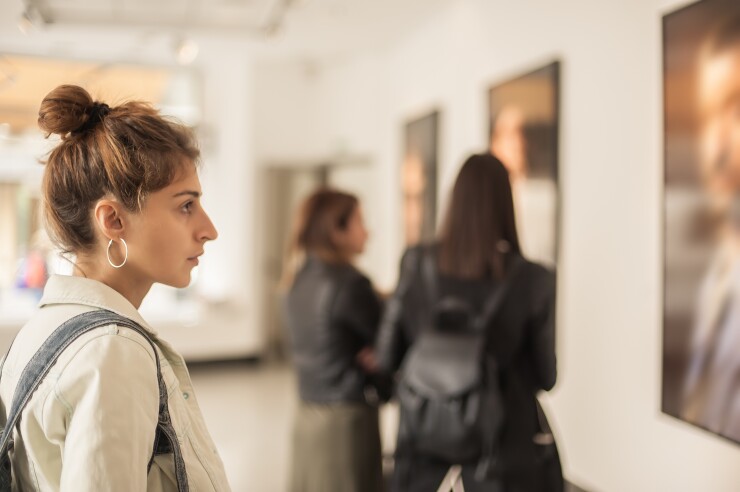Top art dealers will be eagerly waiting to meet some of the world's richest collectors next week, in the castle-like Park Avenue Armory building on Manhattan's tony Upper East Side.
Financial advisors looking to make inroads with the ultrahigh net worth and high net worth segments will want to pay attention to news coming out of
That's because more investors are
"For many of our clients, art is the most important asset on their overall balance sheet," Watson said in a virtual preview call with reporters Wednesday ahead of TEFAF New York's opening.
"More than ever, collectors are viewing art as a strategic asset."
Watson added that clients tend to "view it not in purely financial terms" and also collect art for the aesthetic, intellectual and social cachet it brings.
Bank of America is the lead sponsor again this year for TEFAF and Watson is on the TEFAF Global Advisory Board. Watson works with clients at Bank of America Private Bank and increasingly those at Merrill Wealth Management, too, a Merrill spokesperson said in an email.
'Carrier of their legacy'
"When you're looking at the high net worth, ultrahigh net worth space, it's part of their overall net worth," Watson said of fine art. "It is a strategic source of capital that they unlock with art loans, for example, and it is an important carrier of their legacy."
Around $84 trillion of assets is expected to pass over the next roughly 22 years from aging boomers and other wealthy individuals to younger generations, in what is being called the Great Wealth Transfer, according to

"Fifty-three percent are likely to buy valuable art. That's a staggering figure when you compare it to previous generational cohorts," Watson said. Younger rich investors may be either looking for the value the art brings or "are really wanting a collection that speaks more to their values and choices and lifestyle than those of their parents."
Advisors who can talk to them about fairs like TEFAF could get an edge in winning them over.
Famed galleries including Gagosian, Thaddaeus Ropac and Pace will participate in TEFAF, which is entering its eighth edition in New York with
Offerings range from masterworks of ancient civilizations to modern and contemporary pieces, from dealers who have represented the likes of Picasso, Andy Warhol and Yayoi Kusama — "7000 years of art history," TEFAF Executive Committee President Hidde van Seggelen said in the preview event.
TEFAF will aim to reach the world's largest pool of wealth, which is based in the U.S. and
What's ahead in the art market
But the art market grew at only 3% worldwide last year, a "bit of a plateauing" after it had seen growth around 30% a year after emerging from the pandemic, Watson said.
"From a macro perspective, we've certainly been facing headwinds: inflation, volatility, increasing interest rates certainly over the past year, but the art market still remains resilient," Watson said, adding that it was proceeding on a "slightly more cautious footing." With China loosening COVID restrictions, though, he expects more interest from Asian clients.
Watson predicted an overall "flight to quality" among buyers this season, reflecting concerns about safety in an uncertain market environment.
Identity-based art is likely to also do well. In an
However, with recent "oversaturation," younger artists may sell less well, Watson said. Overall, figurative art and surrealism will find favor, as well as works with prestigious ownership history and "highly conceptual abstraction" — in keeping with the interest in art with strong narratives.

Anticipating that, much of the artwork on display at TEFAF will cater to such tastes with "blue chip" offerings of classics and well-established names and will also include many accomplished female artists. Those will include works by Ukrainian sculptor Louise Nevelson and Austrian abstract expressionist Martha Jungwirth, Van Seggelen said. Bank of America will also stage an "Art in our Communities" exhibition of major female photographers from its own collection.
Interest in digital art such as NFT's remains strong, with growing interest in artificial intelligence-generated art, Watson said — although clients who buy those are also interested in art from other periods, reflecting a trend of "blurring the traditional collecting boundaries."
Bank of America's wealth team will be "hosting clients at the fair throughout the entire run," Watson said. This includes walking the fair together, discerning clients' collecting priorities, introducing them to dealers and later offering services in art lending, consigning, donating to nonprofits and working with foundations and museums.
Looking forward to the fair's highlights, Watson said, "there is going to be a really interesting discussion on the cultural emergency response efforts to conserve art and culture in the Ukraine."








